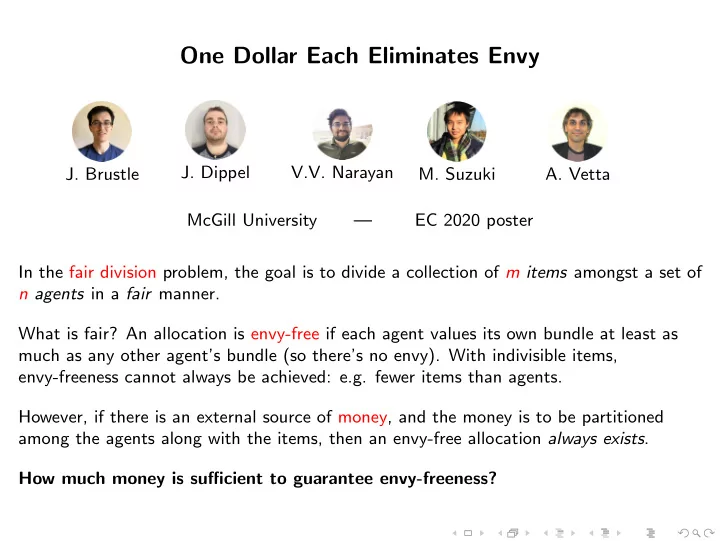

One Dollar Each Eliminates Envy J. Dippel V.V. Narayan J. Brustle M. Suzuki A. Vetta McGill University — EC 2020 poster In the fair division problem, the goal is to divide a collection of m items amongst a set of n agents in a fair manner. What is fair? An allocation is envy-free if each agent values its own bundle at least as much as any other agent’s bundle (so there’s no envy). With indivisible items, envy-freeness cannot always be achieved: e.g. fewer items than agents. However, if there is an external source of money, and the money is to be partitioned among the agents along with the items, then an envy-free allocation always exists . How much money is sufficient to guarantee envy-freeness?
Upper Bounds on the Subsidy We can assume by scaling the agents’ valuations that each item is worth at most a dollar to any agent. This is without loss of generality since it does not affect envy properties. Based on experimental evidence Halpern and Shah (2019) conjectured that when the valuation functions are additive : Conjecture 1. A subsidy of n − 1 dollars is sufficient for envy-freeness. Conjecture 2. There is always an allocation that is both envy-freeable and EF1. In this work, we resolve both conjectures. We show: Theorem 1. For additive valuations there is an envy-freeable allocation where the subsidy to each agent is at most one dollar. (This allocation is also EF1 and can be computed in polynomial time.) Surprisingly, the minimum subsidy is independent of the number of items even for the far more general class of arbitrary monotone valuation functions: Theorem 2. For monotone valuations there is an envy-freeable allocation where the subsidy to each agent is at most 2( n − 1) dollars. (Given a valuation oracle, this allocation can be computed in polynomial time.) One Dollar Each Eliminates Envy June 30, 2020 2 / 4
An Algorithm for Additive Agents Our algorithm for the additive case is simple - repeatedly compute a maximum weight matching between the agents and the items and allocate the matched item to each agent in each round. The resulting allocation is EF1 and can be made envy-free with a payment of just one dollar to each agent - and n − 1 dollars in total! This result is tight, as there are instances that require a minimum subsidy of n − 1 dollars. One Dollar Each Eliminates Envy June 30, 2020 3 / 4
An Algorithm for Monotone Agents Our algorithm for the monotone case begins by computing an EF1 allocation. This can be done in polynomial time by the envy-cycles procedure of Lipton et al. (2004). Then, we simply fix the resulting n bundles and find a utility maximizing allocation of these bundles to the n agents - again, by computing a maximum weight matching. It can be shown that despite losing the EF1 property, the envies in the resulting allocation are still very small. Consequently, this allocation can be made envy-free with very little money: a subsidy of O ( n 2 ) dollars eliminates envy. One Dollar Each Eliminates Envy June 30, 2020 4 / 4
Recommend
More recommend